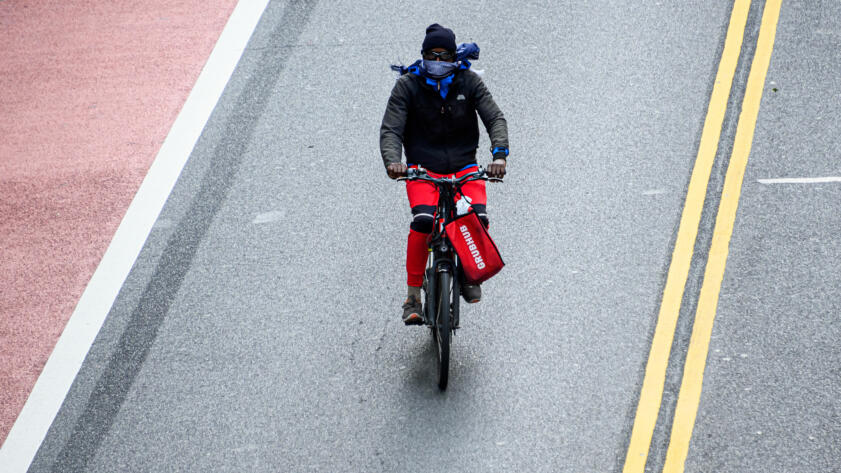At first, the COVID-19 pandemic seemed like a perfect fit for food delivery apps. Restaurants in states with lockdown orders now depend completely on delivery and takeout, while public health authorities are telling consumers to stay indoors. The big four consumer-facing delivery apps—Grubhub, Uber Eats, Postmates, and DoorDash—offer a convenient solution for both parties, accelerating the move to the tech-centric, gig-economy-powered Delivery World of tomorrow.
It hasn’t quite worked out that way.
Instead, some consumers are walking away from delivery apps, restaurants are struggling to make delivery sustainable, and there’s potentially a bigger problem even a captive consumer base hasn’t solved.
“Their current models don’t really work,” said Dan Fleischmann, a vice president at Kitchen Fund, a venture capital firm that invests in food startups. “It just doesn’t really work for anyone. It doesn’t work for the restaurant. It doesn’t work for the third-party delivery provider.”
Even Before the Pandemic, Things Weren’t Looking Great
In August 2019, analysts from the investment firm Cowen estimated that Uber Eats was losing $3.36 on every order and would continue to lose money on every order for the next five years. Uber CEO Dara Khosrowshahi acknowledged that Uber Eats is not yet profitable in an email to employees in March after its parent company laid off more than 3,700 employees. “While Eats growth is accelerating, the business today doesn’t come close to covering our expenses,” he wrote. When asked about the profitability of Uber Eats, Uber spokesperson Sarah Abboud referred The Markup to the company’s 2020 first quarter earnings report.
In early March, DoorDash filed to go public despite losing an estimated $450 million in 2019, according to The New York Times. DoorDash declined to comment on that estimate or its path to profitability, but regarding the latter CEO Tony Xu told Fortune in February that “we’re working our way there.”
Postmates, the smallest of the four companies by market share, was privately valued at up to $2.4 billion in 2019 but delayed its IPO filing after investors started drawing comparisons to grossly overvalued WeWork. Postmates did not respond to a request for comment. Meanwhile, other companies have been ditching the food delivery business: Yelp sold Eat24 to Grubhub, Square sold Caviar to DoorDash, and Amazon shut down its Amazon Restaurants delivery service.
“Bottom line is that you need to pay someone enough money to drive to the restaurant, pick up food and drive it to a diner.
Grubhub letter to shareholders
Grubhub, which also owns Seamless, is publicly traded and the only one of the big four that has achieved profitability. Still, it lost more than a third of its value after revenue fell below investors’ expectations in the third quarter of 2019. In a letter to shareholders, the company revealed two things: Customers were “promiscuous,” or not loyal to the Grubhub platform, and the delivery part of the business was fundamentally not profitable. Instead, delivery was just a “means to an end”—getting restaurants to sign up on the Grubhub platform and then upselling them on “marketing” benefits, like greater visibility in Grubhub’s search results. In other words, like many tech companies, GrubHub is primarily an advertising company.
“Bottom line is that you need to pay someone enough money to drive to the restaurant, pick up food and drive it to a diner. . . ,” the company wrote. “At some point, delivery drones and robots may reduce the cost of fulfillment, but it will be a long time before the capital costs and ongoing operating expenses are less than the cost of paying someone for 30-45 minutes of their time.”
And while Grubhub’s “active diners” increased by 24 percent during the first quarter of 2020, the company still reported a $33 million loss.
When asked about profitability, Grubhub spokesperson John Collins pointed to its first quarter 2020 earnings call, during which CEO Matt Maloney said that the pandemic has been a “net tailwind” but that the company is not focused on profitability during the pandemic. “The company has made a decision to reinvest as much as possible into supporting restaurant owners right now. We only do well when they do well. Supporting them is our priority right now,” Collins said in an email.
Now Small Restaurants Are Hurting—and That’s Where Apps Get Their Dollars
The big issue with the business model, which the pandemic has only exacerbated, is how apps generate the bulk of their revenue: charging high fees to small restaurants.
The big four depend on charging between 10 and 30 percent to independent restaurants and small chains, said Matt Newberg, a food industry consultant and founder of the trade publication Hngry.tv. Big chains get a better deal because their name recognition brings new customers to the platforms, he said. It may also be that the big chains successfully engaged in “arm-twisting” to lower fees, as The Wall Street Journal reported.
Grubhub has acknowledged that it makes more money from independent restaurants and small chains. A February 2020 shareholder letter explained that a typical order from an independent restaurant that uses Grubhub for marketing and delivery generates $4 of profit for Grubhub, while an order from a national chain generates $0.
The independent restaurant “values our demand generation capabilities and utilizes our delivery services; we have a higher take-rate and collect the diner delivery fee,” Grubhub wrote, while the profit from the national brand “is significantly lower because the commission rate is lower AND the order size is smaller.”
For the independents, though, the delivery fees were too high “even in a strong market,” said Andrew Rigie, the executive director of the New York Hospitality Alliance. In a pandemic, they could put restaurants out of business—which would in turn put delivery apps out of business.
Restaurant Sales Dropped 50 Percent in Two Months
Total Restaurant Sales in Billions
$0b
$20b
$40b
$60b
$80b
Jul
2019
Oct
Jan
2020
Apr
The lockdown is certainly devastating for restaurants. Sales were down 50 percent from just two months before, according to an April survey by the National Restaurant Association, and 3 percent of restaurants have permanently closed due to the pandemic.
Delivery apps do seem to be helping keep some restaurants from shuttering in the short term, but the future is murky.
Evan Franca, owner of Brooklyn Crepe & Juice, testified at a remote New York City Council hearing in April that 20 percent of his business now comes in through his pickup window, and the other 80 percent comes from online orders. He estimates he loses money on online orders but has chosen to keep accepting them in order to keep his staff and stay connected to customers.
“Right now I’m just trying to keep my staff employed and keep the lights on until the situation improves,” he said.
The tech companies seem to recognize that their revenue base is vulnerable to collapse. Uber Eats waived signup fees to some restaurants and waived delivery fees to customers at 100,000 restaurants indefinitely. Postmates waived fees for businesses in the Bay Area, L.A., Sacramento, and Detroit, and DoorDash cut fees in half for more than 150,000 restaurants through the end of May. DoorDash told The Markup it will not be collecting waived fees, and Uber Eats said the signup fee waivers are still in place for now.
Grubhub is deferring fees for some independent restaurants but not waiving them. “We have not collected any fees as of today and the timeline/process remains flexible,” Collins said.
“In a normal situation, this was barely profitable for the restaurant. In a situation where we’re 100 percent off-premises, it just flat out doesn’t make sense,” Newberg said. “The reason people are going to continue to do it now is you look at your numbers, all the commissions are zero. But it’s unclear if you’re going to have these guys come after you in the future and try to collect on the fees that they would be getting right now.”
The Public Is Getting Savvy About the Skewed Economics
Cities including Seattle, San Francisco, New York, Jersey City, and Washington, D.C., have temporarily capped the fees delivery app companies can charge restaurants. Customers are learning that those fees mean that ordering directly is the best way to support their favorite restaurants.
Andrew Martino is the owner of Ghost Truck Kitchen in Jersey City, which offers different cuisines out of the same kitchen for pickup, delivery, and catering. He had already been lobbying his customers to order directly from his restaurant instead of by delivery apps, but he’s found the message is suddenly connecting.
“The data shows that there’s been an uptick with people ordering directly through our website as opposed to the third-party carriers,” he said. “And then furthermore, we have far more customer advocates explaining what’s happening out there.”
Apps Are Trying to Save Themselves
The bad numbers are likely the reason Uber is now in talks to buy Grubhub, in the hope that more market power will translate to more profits. The scale created by the merger could potentially add up to a viable business, Kitchen Fund’s Fleischmann said, but it still might not survive outside the top five markets for delivery—New York City, San Francisco, Miami, Boston, and L.A.—especially in a post-pandemic recession.
Meanwhile, the delivery apps have been trying to market themselves as an aid to struggling restaurants. “I still get barrage after barrage of emails, you know, telling me about how great this promotion is they’re running,” says Andrew Martino, owner of Ghost Truck Kitchen. “But you know, all the fine print isn’t beneficial to restaurants. It’s all beneficial to the apps.”
The truth is, the apps will probably continue to struggle themselves. “They’re hurting,” Fleischmann said. “They were already losing money on every order. I really don’t know what the answer is there.” With no quick end to the pandemic in sight and a likely struggling economy to follow, there may not be one.
Correction
An earlier version of this story said that Grubhub is the only one of the big four delivery app companies that is publicly traded. Uber, the parent company of Uber Eats, is also publicly traded.





